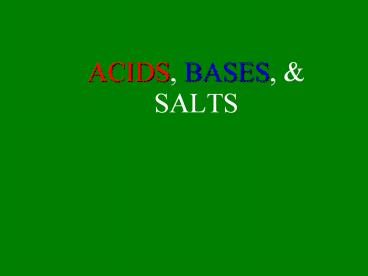ACIDS, BASES, PowerPoint PPT Presentation
Title: ACIDS, BASES,
1
ACIDS, BASES, SALTS
2
Properties of Acids
- sour taste
- electrolytes
- - aqueous solns conduct electric current
- react with bases to form water and salt
(neutralization reaction) - react with most metals to produce H2(g)
- acids turn litmus paper red
3
Electrolyte
- substance that dissolves in H2O to produce soln
that conducts electric current - acids, bases, salts are electrolytes form
ions in H2O - HCl(s) ? H1(aq) Cl-1(aq)
- NaOH(s) ? Na1(aq) OH-1(aq)
- NaCl(s) ? Na1(aq) Cl-1(aq)
4
Which metals react with acids?
- See Table J
- All metals above H2 react with acids
- Cu, Ag, and Au do not react with acids
5
2HCl Mg ? MgCl2 H2
- Mg above H2 so reaction proceeds
- single replacement reaction occurs
6
Properties of Bases
- bitter taste
- slippery or soapy feeling
- Electrolytes
- react with acids to produce water and salt
- bases turn litmus paper blue
7
Formula of Acid
- Format HX
- where X nonmetal (F, Cl, Br, I)
- or
- X negative polyatomic ion
- some acids have 2 or 3 Hs
- Ex HF, H2S, H3PO4
8
Formula of Base
- Format MOH
- where M is metal
- Ex NaOH, Ca(OH)2
- exception NH3 and NH41
- CH3OH is NOT a base. WHY?
9
Identify the Electrolytes
- NaCl
- C2H5OH
- H2SO4
- NaOH
- C6H12O6
- CaI2
- HF
- Mg(OH)2
- C3H7OH
- CCl4
- HNO3
- C5H12
- K3PO4
- CH3OCH3
- LiOH
- HI
- (NH4)2SO4
- C12H22O11
10
Acid, Base, or Neutral?
- all H2O contains some H1 and some OH-1 ions
- pure H2O concentrations very low
- neutral solution H1 OH-1
- acidic solution H1 gt OH-1
- basic solution OH-1 gt H1
11
Water self-ionization
- H2O(l) H2O(l) ? H3O1(aq) OH-1(aq)
- H3O1 hydronium ion
- OH-1 hydroxide ion
- H2O(l) ? H1(aq) OH-1(aq)
- H1 and H3O1 used interchangeably
- H1 called proton or hydrogen ion
12
(No Transcript)
13
Arrhenius Acid
- substance that contains hydrogen ionizes to
produce H1 ions in (aq) soln - HCl(g) ? H1(aq) Cl-1(aq)
- HNO3 ? H1(aq) NO3-1(aq)
14
Arrhenius Base
- substance that contains hydroxide group ionizes
to produce OH-1 ions in (aq) soln - NaOH(s) ? Na1(aq) OH-1(aq)
15
Arrhenius Salt
- electrolyte where H1 not only () ion and OH-1
not only (-) ion formed in aqueous solution - Ex NaCl, CaBr2,KNO3, NH4I
16
Salts in Water (ionic compounds)
- NaCl(s) ? Na1(aq) Cl-1(aq)
- CaBr2(s) ? Ca2(aq) 2Br-1(aq)
- KNO3(s) ? K1(aq) NO3-1(aq)
- NH4I(s) ? NH41(aq) I-1(aq)
17
Arrhenius Model has limitations
- Dont always use H2O as solvent
- Arrhenius model only applies when H2O is solvent
- Doesnt explain all cases
- NH3 (base) doesnt contain OH-1 but it produces
OH-1 - NH3(g) ? NH41(aq) OH-1(aq)
18
Alternate Theory Bronsted-Lowry
- Acid is a proton donor
- All Arrhenius acids Bronsted-Lowry Acids
- H1
- HX(g) H2O(l) ? H3O1 X-1
- H1 forms molecule-ion bond with water molecule ?
H3O1 (hydronium ion)
19
Bronsted-Lowry Acids
H1
- HCl H2O ? H3O1 Cl-1
- HNO3 H2O ? H3O1 NO3-1
- H2SO4 H2O ? H3O1 HSO4-1
- HSO4-1 H2O ? H3O1 SO4-2
H1
H1
H1
20
Bronsted-Lowry Base
- Base is proton acceptor
- OH-1 is base
- H1 OH-1 ? H2O
- not restricted to aqueous solution
- NH3 H2O ? NH41 OH-1
- NH3 is a base!
21
(No Transcript)
22
Amphoteric
- substance that acts as both acid base
- H2O is amphoteric
- HX(g) H2O(l) ? H3O1 X-1
- (base)
- NH3 H2O ? NH41 OH-1
- (acid)
23
(No Transcript)
24
Naming Acids Bases
25
Naming Binary Acids
- Hydro stem of nonmetal ic
- HF ?
- HCl ?
- H2S ?
Hydrofluoric acid
Hydrochloric acid
Hydrosulfic acid
26
Naming Ternary Acids
- Name derived from polyatomic anion (see Table E)
- Replace ite with ous , add acid
- HNO2 is nitrous acid
- Replace ate with ic, add acid
- HNO3 is nitric acid
27
Ternary Acids
- polyatomics with S and P, make stem long again
- H3PO4 phosphoric acid, not phosphic acid
- H2SO4 sulfuric acid, not sulfic acid
- H2SO3 sulfurous acid, not sulfous acid
- SEE TABLE K
28
Naming Bases
- Name the metal hydroxide
- NaOH ?
- Ca(OH)2 ?
- Mg(OH)2 ?
Sodium hydroxide
Calcium hydroxide
Magnesium hydroxide

